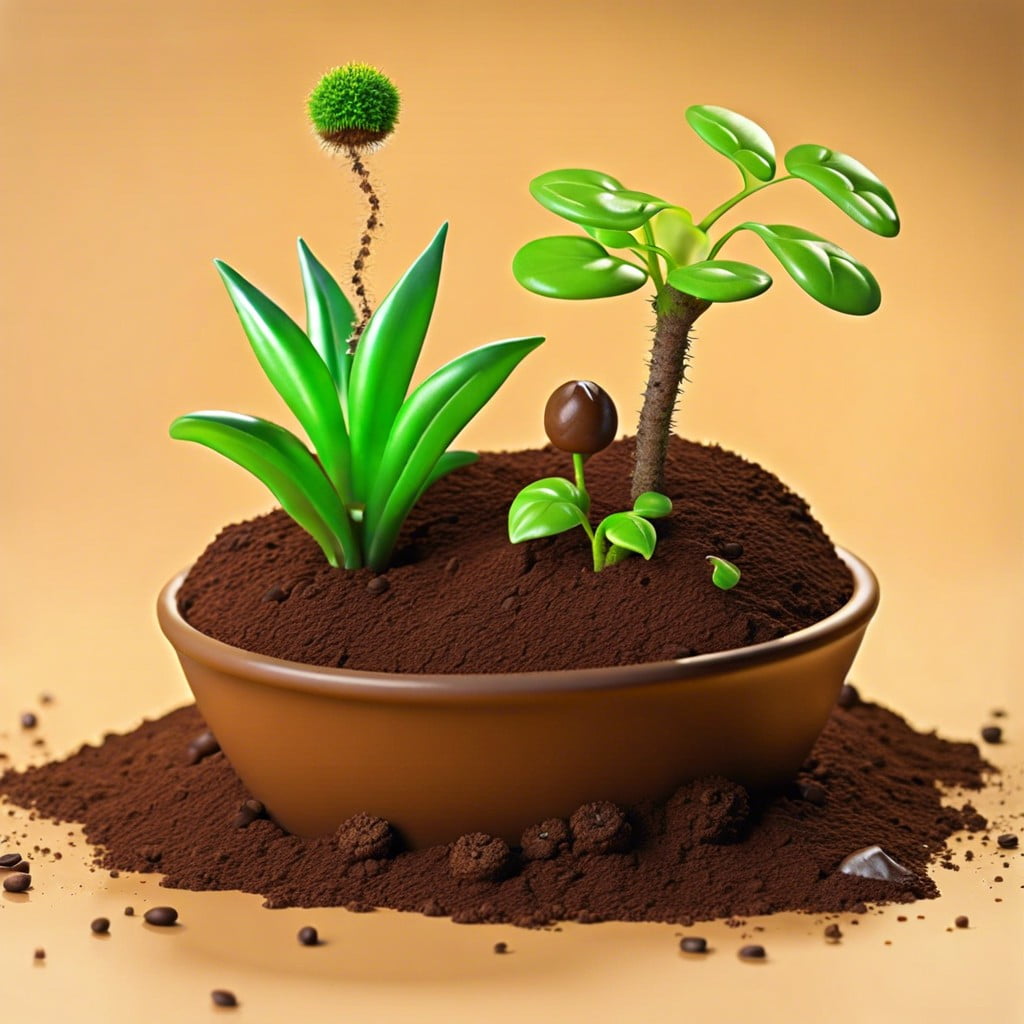Discover which plants may frown upon the addition of coffee grounds to their soil in this informative guide.
Acidic Soil Disfavor

Contrary to popular belief, spent coffee grounds are not acidic. They’re neutral in pH, but the misconception persists. Nonetheless, some plants are less tolerant of coffee grounds because of their composition. Fresh coffee grounds contain compounds that can suppress plant growth, beneficial for acid-loving plants but detrimental to others. Over time, the nitrogen in coffee grounds becomes available to plants, but it can initially cause nitrogen depletion as microorganisms break down the organic matter, competing with plants for this essential nutrient.
For gardeners dreaming of thriving vegetation, it’s crucial to recognize that plants such as tomatoes, asparagus, and alfalfa might not respond well to coffee grounds. It’s sage advice to keep grounds away from these crops. On the flip side, blueberries, rhododendrons, and azaleas might just tip their hats to you for using coffee grounds. They favor the potential for slightly increased acidity and nitrogen-rich soil amendments. Remember, moderation is key; too much of this good thing can lead to an overdose for your green friends.
Caffeine Sensitivity in Plants
Just as caffeine can jolt us awake, some plants react poorly to it. Coffee grounds contain caffeine which can inhibit growth in plants sensitive to this compound. For instance, tomatoes and chili peppers might not be your java’s best friends. They can experience stunted growth due to the caffeine kick.
It’s not all plants that have this aversion, though. Evergreens, such as pine, meanwhile, wouldn’t mind sipping on the leftovers from your morning routine. But let’s stick to the sensitive ones – your green pals like orchids, roses, and even clover. These plants may display signs like yellowing leaves or halted development when caffeine overstays its welcome.
Think of caffeine as that colleague who’s bursting with energy. Not everyone can keep up with that pace — some prefer a more serene work environment. Similarly, a garden has its own dynamics, and caffeine from coffee grounds might disrupt the balance for select vegetation. Consider the individual needs of your plants before inviting coffee to the potting mix party.
Fungal Growth Proneness
A cozy blanket of coffee grounds might seem like the perfect winter wrap for your plants, but hold your grounds! Some fungi are party crashers waiting for an invite to that warm bed. Fresh coffee grounds can be particularly inviting to certain types which adore the acidic and moist environment they provide.
Watch out for no-show plants like roses – they might throw a fit. Coffee grounds can foster the growth of Rosellinia necatrix, a fungus that’s no friend to these beauties. Rhododendrons and azaleas could also sulk, falling prey to phytophthora root rot when coffee grounds overstay their welcome.
But fear not! If you’re keen on incorporating coffee grounds, moderation is key—think of it as seasoning rather than the main course. Composting coffee grounds before use might save the drama, as it balances the fungal mix and ensures no one gets upset. Keep an eye on your garden guests, and make sure fungi don’t crash the plant party.
Coffee Grounds Misconceptions
Many gardeners believe coffee grounds are a cure-all for their compost or garden soil, but this isn’t always the case. Let’s brew up some clarity on this matter. Firstly, used coffee grounds are not highly acidic, as they lose much of their acidity during the brewing process. Nonetheless, they shouldn’t be dumped in bulk around plants without consideration of soil balance.
Another tall tale is that coffee grounds deter pests because of their strong smell and caffeine content. However, while they may have some minor pest repellant properties, they aren’t a substitute for more effective, targeted pest control methods.
Lastly, there’s the notion that coffee grounds are a direct nitrogen boost. In truth, they’re more of a slow-release nitrogen source. They need to decompose before releasing nutrients, which doesn’t happen overnight—or even over a few brews.
If you remember one sip from this coffee chat, let it be that while coffee grounds can be beneficial, they aren’t a magic bean for plant growth. They should be used thoughtfully as part of a broader garden care strategy.
Proper Application Methods
Before adding coffee grounds to your garden, test your soil’s pH level; plants such as azaleas and blueberries thrive in acidic soil, while others prefer neutral pH. For acid-lovers, sprinkle coffee grounds sparingly around the base.
If you’re integrating coffee grounds into compost, aim for a balanced mix; coffee grounds should be no more than 20% of the material to avoid nitrogen overload.
When using as a natural pest deterrent, a thin layer of grounds near vulnerable plants can ward off slugs and snails, but beware — a thick layer can hinder the necessary air and water from reaching the soil.
To prevent mold, mix coffee grounds into the soil rather than leaving them on the surface. This fosters good aeration, drastically reducing the chances of fungal diseases.
Remember, less is more. Start small, monitor your plants’ reactions, and adjust as needed. Coffee grounds can be a garden ally, but only with judicious use.